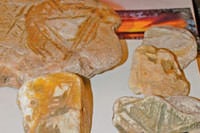[/caption] Classify this under news of the weird. A Russian scientist claims that aliens downed the Tunguska meteorite 101 years ago to protect our planet from devastation. Yuri Lavbin says he found unusual quartz crystals at the site of the massive Siberian explosion. Ten crystals have holes in them, placed so the stones can be united in a chain, and other have drawings on them. "We don't have any technologies that can print such kind of drawings on crystals," said Lavbin. "We also found ferrum silicate that can not be produced anywhere, except in space."
OK, just a few holes in this story, too.
[caption id="attachment_31440" align="aligncenter" width="240" caption="Photograph from the Soviet Academy of Science 1927 expedition led by Leonid Kulik"]
[/caption] The Tunguska Event was a powerful explosion that occurred in an uninhabited and desolate area near the Tunguska River in Russia, on June 30, 1908. Although the cause of the explosion is the subject of debate, it is commonly believed to have been caused by the explosion of a large meteoroid or comet fragment, occurring the in Earth's atmosphere about 5–10 kilometers (3–6 miles) high. The blast flattened an estimated 60 million trees over 2,150 square kilometers, but no crater or "smoking gun" meteorite has ever been found. Different studies have yielded varying estimates of the object's size, but there is general agreement that it was a few tens of meters across.
A couple of expeditions have gone to the remote site of the crash. Lavbin says that one expedition located the unusual crystals.
While I'm not a chemist, I couldn't find any information on "ferrum silicate." Seemingly, it doesn't exist.
One small, nondescript photo accompanied Lavbin's claims,
published by the Macedonian International News Agency.
This isn't the first time a UFO has been claimed to associated with the Tunguska event.
Another report from 2004
said a scientific expedition to the site found blocks of an extraterrestrial technical device, and one 50-kilogram piece of the stone was brought to the city of Krasnoyarsk to be studied and analyzed. No subsequent reports or analysis could be located during an internet search.
Other claims of exploding alien spaceships or alien weapons detonating to "save the Earth from an imminent threat" appear to originate from a science fiction story "A Visitor From Outer Space" written by Soviet engineer Alexander Kazantsev in 1946, in which a nuclear-powered Martian spaceship, seeking fresh water from a lake blew up in mid-air. This story was was said to be inspired by Kazantsev's visit to Hiroshima in late 1945.
Many events in Kazantsev's tale were subsequently confused with the actual occurrences at Tunguska. A "reveal-all" book was published in 1976 (The Fire Came By) but was written by two television drama critics -- so much for a scientific background. In 1998 the television series The Secret KGB UFO Files was broadcast on Turner Network Television, and referred to the Tunguska event as "the Russian Roswell" and claimed that crashed UFO debris had been recovered from the site.
However, not one proponent of the Tunguska/UFO hypothesis have ever been able to provide any significant evidence for their claims.
Lavbin says the stones, when put together form a map, and might be part of a navigational system of a spaceship.
But Lavbin says what proves his hypothesis is a strange portrait of a strange person on one of the stones.
Hmm, strange looking person on a stone….sounds like....pareidolia.
Check out the Bad Astronomer's take on that phenomenon.
Just as in any other UFO claim, this one fails to deliver any evidence.
Source:
Mina
 Universe Today
Universe Today
